Abstract
Under the “dual-carbon goals” (carbon peaking and carbon neutrality), the accelerated global transition toward green and low-carbon development has become an irreversible trend. As a key carbon-emitting sector in China, the transportation industry accounts for approximately 10% of the nation’s total carbon emissions. Transportation decarbonization is therefore critical not only for addressing global climate change challenges and fulfilling international emission reduction commitments but also for driving the industry’s green transformation, optimizing energy structures, enhancing public livelihood and ecological environment quality, and, ultimately, achieving sustainable development. Taking Chengdu as a case study, systematically, this paper (1) objectively summarizes the current status and achievements of green development in Chengdu’s transportation sector; (2) identifies bottlenecks hindering its green transition; (3) calculates carbon emissions across various transport modes in recent years using the GHG Protocol framework to identify key influencing factors; and (4) proposes targeted strategies to establish Chengdu as a national pioneer in developing innovative “dual-carbon” pathways for transportation. The findings are intended to provide decision-making support for building a low-carbon transportation system that aligns with Chengdu’s megacity development goals.
1. Introduction
Facing the severe challenges posed by global climate change, reducing greenhouse gas (GHG) emissions and achieving green, low-carbon development have become a global consensus [1]. As the world’s largest developing country and carbon emitter, China recognizes its critical responsibility in addressing climate change [2]. To promote a global low-carbon transition, protect the ecological environment, and realize sustainable development, China has proactively committed to the “dual-carbon goals” of carbon peaking and carbon neutrality [3,4]. The establishment of these goals not only demonstrates China’s firm resolve to tackle climate change but also reflects its willingness to collaborate with the international community in building a future of harmonious coexistence between humanity and nature. Through the implementation of this dual-carbon strategy, China will lead domestic energy structure optimization, drive industrial green upgrading, and contribute Chinese wisdom and solutions to global climate governance [5,6]. In December 2024, the Climate Change Response Report (2024) (hereinafter referred to as the Report), jointly compiled by the Chinese Academy of Social Sciences and the China Meteorological Administration, was released in Beijing. The Report indicates that, under the carbon neutrality target, the global trend toward accelerated green and low-carbon transition is irreversible. The transportation sector, as one of the foundational pillars for economic and social prosperity, stability, and sustainable development, plays a crucial role in national long-term strategies under the dual-carbon goals by reducing air pollutants and CO2 emissions while advancing green and low-carbon development [7,8,9]. Therefore, it is imperative to conduct carbon emission accounting and analysis for the transportation sector and systematically explore optimization pathways for emission reduction, thereby facilitating the industry’s transition toward sustainable and low-carbon development.
This study selects Chengdu as a representative case due to its typicality and exemplary significance as a high-density megacity in western China. Chengdu leads the nation in motor-vehicle ownership, with road-freight transport accounting for over 80% of total freight volume. This “high vehicle ownership + road-dominated” transportation structure epitomizes the common challenges emerging from China’s rapid urbanization. Additionally, Chengdu is currently spearheading its development under the guiding principle of building a demonstration zone for park cities that fully embodies the new development philosophy. With a focus on synergistic pollution reduction and carbon mitigation in the transportation sector, the city is actively advancing the green and low-carbon transformation of its transport structure [10,11,12]. Both the “Decision of the CPC Chengdu Municipal Committee on Optimizing Spatial, Industrial, Transportation and Energy Structures to Promote Urban Green and Low-carbon Development with the Goal of Achieving Carbon Peak and Carbon Neutrality”, adopted at the 10th Plenary Session of the 13th Chengdu Municipal Party Committee [13], and the 14th Chengdu Municipal Party Congress explicitly propose the coordination and promotion of the optimization and adjustment of “four major structures” (space, industry, transportation, and energy) guided by the carbon peak and carbon neutrality goals, thereby facilitating urban green and low-carbon development. To actively implement these directives and promote transportation structure optimization as part of the “four major structures” adjustment, the municipal government has issued the “Chengdu Action Plan for Optimizing Transportation Structure to Promote Urban Green and Low-carbon Development” and the “Chengdu Policy Measures for Optimizing Transportation Structure to Promote Urban Green and Low-carbon Development” [14]. These documents clearly outline the following four key tasks: “promoting green travel, optimizing freight structure, promoting new energy vehicles, and advancing green smart transportation infrastructure construction”. Since the implementation of these policies, Chengdu has achieved certain results in green transportation development. However, the current challenges remain daunting, with significant gaps compared to national requirements, leading cities, and the city’s own targets. Persistent pain points and difficulties remain prominent and wide-ranging [15,16]. Therefore, there is an urgent need to further focus on the key priorities and critical challenges in advancing green development within Chengdu’s transportation sector. This entails adopting scientific methods to assess the carbon emission pathways of the transportation system, systematically analyzing the influencing factors of transportation-related carbon emissions and proposing targeted countermeasures and recommendations for advancing green development under the dual-carbon goals. The findings of this study provide a robust theoretical foundation for facilitating green and low-carbon transformation in Chengdu’s transportation sector.
2. Materials and Methods
2.1. Model Selection
The term “transportation carbon emissions” [17,18] specifically refers to emissions generated by mobile sources (i.e., vehicles), while stationary sources within the transportation sector—such as airport terminals and port facilities—are excluded from this research scope [19]. “Carbon emissions” [20,21,22,23] in this context encompass both direct CO2 emissions from fossil-fuel combustion and indirect emissions from electricity consumption. Given their negligible contribution (less than 0.1% combined), methane (CH4) and nitrous oxide (N2O) emissions are simplified and excluded from calculations in this study. Current mainstream carbon emission models include the MARKet ALlocation (MARKAL) model, the Asia–Pacific Integrated Assessment Model (AIM), and the Long-range Energy Alternatives Planning (LEAP) model. Developed by the Lawrence Berkeley National Laboratory, the LEAP model represents a scenario-based energy–environment simulation platform specifically designed for energy planning, particularly long-term strategic planning. Compared with alternative models, LEAP demonstrates the following three distinctive advantages: (1) enhanced structural robustness enabling seamless integration with general economic models, end-use consumption patterns, and energy supply systems; (2) capability to evaluate the impacts of energy conservation technologies and specific mitigation strategies through comprehensive policy simulations; (3) a dedicated Technology and Environmental Database (TED) that compiles emission indicators for various technologies across different countries into a comprehensive database. This system allows researchers to expand the database based on regional-specific conditions, thereby significantly facilitating environmental impact assessments. Considering these technical merits and adaptability requirements, the LEAP model is selected as the primary computational tool for carbon emission analysis in this research.
2.2. Model Framework
The LEAP model, an integrated energy–environment scenario analysis platform incorporating energy systems, environmental impacts, and socioeconomic development, is widely employed in energy policy evaluation and climate change mitigation studies. Its modular architecture comprises the following five core components: energy demand, environmental emissions, energy conversion, biomass resources, and cost analysis. Users can establish customized scenarios by inputting quantitative parameters reflecting current conditions and projected socioeconomic/energy development trajectories, enabling systematic comparisons of alternative policy outcomes.
In this study, only the Energy Demand Module and Environmental Impact Assessment Module were utilized to quantify transportation-related CO2 emissions in Chengdu. Based on the transportation mode’s characteristics, the city’s transport sector was classified into the following eight categories: private cars, taxis, buses, motorcycles, metro, road transport, railway transport, and civil aviation. Three of these categories—road transport, railway transport, and civil aviation—were further subdivided into passenger and freight sub-sectors, resulting in six specialized operational units. Sector-specific emission inventories were systematically aggregated to derive the total carbon emissions for Chengdu’s transportation system. Figure 1 illustrates the LEAP-based analytical framework for transportation carbon emissions in Chengdu.
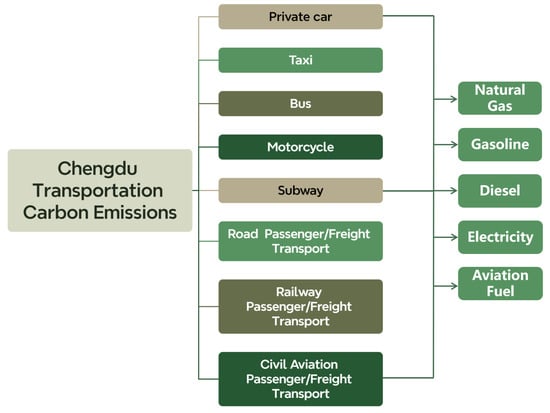
Figure 1.
The LEAP-based analytical framework for transportation carbon emissions in Chengdu.
2.3. System Boundaries
This study adopts a comprehensive “macro-transportation” scope [24], encompassing road transport, railway, civil aviation, waterway transport, urban rail transit (e.g., metro), public buses (including electric buses), taxis, and non-operational transport. Non-operational transport comprises privately owned vehicles (e.g., passenger cars, and motorcycles), logistics vehicles, sanitation vehicles, and other social service vehicles [25,26,27]. Due to data availability constraints, pipeline transport and non-road transport (e.g., agricultural machinery) are excluded, while civil aviation coverage is limited to commercial aviation, excluding general aviation [28].
A critical challenge in transportation emission accounting lies in defining spatial and operational boundaries for mobile emission sources [29]. To align with statistical reporting conventions, the energy consumption and emission boundaries in this study are structured as follows:
Road transport, civil aviation, waterway transport, public buses, taxis, and non-operational transport adhere to the territorial principle, accounting exclusively for vehicles, vessels, and aircraft registered within Chengdu’s administrative jurisdiction [30,31].
Railway emissions are calculated based on the operational scope of the Chengdu Railway Bureau rather than municipal administrative boundaries, as railway energy consumption data are aggregated by rail networks rather than geographic divisions [32]. While this approach may overestimate Chengdu’s emissions, it aligns with the city’s energy efficiency evaluation protocols for the Chengdu Railway Bureau and addresses practical challenges in disaggregating railway energy data at the municipal level.
Urban rail transit emissions are confined to the traction energy consumption of Chengdu’s metro system [33,34,35]. Empirical data indicate that metro traction accounts for approximately 50% of total energy consumption in urban rail transit operations.
The system boundaries further incorporate Scope 1, Scope 2, and Scope 3 emissions in accordance with ISO 14064 standards [36], defined as follows:
Scope 1: Direct emissions occurring within Chengdu’s administrative boundaries (e.g., gasoline combustion from vehicles operating within the city).
Scope 2: Indirect emissions from electricity consumption within Chengdu’s boundaries (e.g., electricity-powered metro operations).
Scope 3: Transboundary emissions induced by activities originating within Chengdu, including aviation emissions from flights departing/arriving in Chengdu and freight transport emissions from trucks servicing the city.
2.4. Computational Methodology
This study integrates the following two distinct calculation approaches: ton–kilometer-based method [37] and the vehicle stock-based method [38]. The methodological selection follows a hierarchical principle: ton–kilometer statistics (e.g., passenger–kilometers and freight–ton–kilometers) are preferentially applied where available, while vehicle stock data (e.g., registered vehicles and annual mileage) serve as supplementary inputs for sectors lacking systematic turnover metrics. A detailed classification of the computational methodologies adopted for each transport category is provided in Table 1.

Table 1.
Calculation methods by transport type.
2.4.1. Ton–Kilometer/Passenger–Kilometer-Based Method
The ton–kilometer/passenger–kilometer-based method calculates total carbon emissions by multiplying the actual transportation workload (e.g., freight “ton–kilometers” or passenger “passenger–kilometers”) by carbon emission factors per unit turnover. This approach emphasizes the operational efficiency of transport activities, requiring high-precision data inputs. In this study, road transport, railway, civil aviation, and metro systems were analyzed using this method. Following the 2006 IPCC Guidelines for National Greenhouse Gas Inventories, transportation emissions are classified as mobile source emissions. The calculation formula, based on turnover metrics and associated parameters, is expressed as follows:
where is the total carbon emissions; is the turnover volume (ton–kilometers or passenger–kilometers); is the share of fuel type in transport category ; is the energy consumption coefficient per unit turnover for fuel in category ; and is the carbon emission factor for fuel in category .
2.4.2. Vehicle Stock-Based Method
The vehicle stock-based method estimates total carbon emissions by multiplying the registered vehicle/equipment population (e.g., total private cars in a region) by the average annual carbon emissions per vehicle. This approach reflects the aggregate impact of fleet size on emissions and is suitable for macro-level policy analysis, necessitating vehicle stock statistics and average utilization intensity data. In this study, buses, taxis, private cars, and motorcycles were evaluated using this method. The computational formula is defined as follows:
where is the total carbon emissions; is the vehicle stock; is the annual mileage per vehicle; is the fuel consumption per 100 km for fuel in transport category ; and is the emission factor for fuel in category .
2.5. Parameter Settings
2.5.1. Emission Factors
Emission factors for various transport modes should ideally be determined through empirical testing to accurately reflect the technological proficiency of combustion equipment and region-specific emission profiles in Chengdu. However, due to practical constraints in obtaining localized experimental data, this study primarily adopts recommended coefficients from the National Guide for Atmospheric Pollution Source Emission Inventories [39] aligned with GHG Protocol [40] recommendations. These coefficients ensure methodological consistency and compliance with national regulatory standards. Detailed emission factors and their corresponding transport categories are systematically tabulated in Table 2.

Table 2.
Emission factors and energy consumption coefficients.
2.5.2. Energy Consumption Coefficient per Unit Turnover
For setting the energy consumption coefficients of intercity transportation modes in the base year, this study references research findings from Research on Medium- and Long-Term Energy Conservation in China’s Transportation Sector, China Transportation Yearbook, corporate reports, and related literature. Specific parameter settings are detailed in Table 3.

Table 3.
Future energy consumption per unit levels for freight and passenger transport under different scenarios.
2.5.3. Energy Consumption per 100 km
The energy consumption per 100 km in this study references The Chengdu 14th Five-Year Plan for Integrated Transportation and Logistics Development and national transportation policy documents, such as the Ministry of Science and Technology’s 2017 Annual Project Application Guide for New Energy Vehicle Pilot Programs and the State Council’s Energy-Saving and New Energy Vehicle Industry Plan (2012–2020) [41], among others (as detailed in the table). Specific parameter settings are provided in Table 4.

Table 4.
Energy consumption per 100 km for different vehicles.
3. Results
3.1. Total Transportation Carbon Emissions in Chengdu
Based on current data on vehicle populations, transportation activity levels, energy efficiency, and emission factors, this study quantifies the carbon emissions inventory of Chengdu’s major transport sectors over the past five years. As shown in Figure 2, total transportation emissions remained relatively stable from 2017 to 2022. However, significant fluctuations emerged in 2023, driven primarily by a surge in travel demand following the post-pandemic recovery. In 2024, Chengdu’s transportation carbon emissions reached 31.17 million metric tons (MtCO2), marking a 0.7% increase compared to 2023. Private car travel, road freight transport, and civil aviation accounted for the largest shares at 40.1%, 16.6%, and 26.0%, respectively, as illustrated in Figure 3.
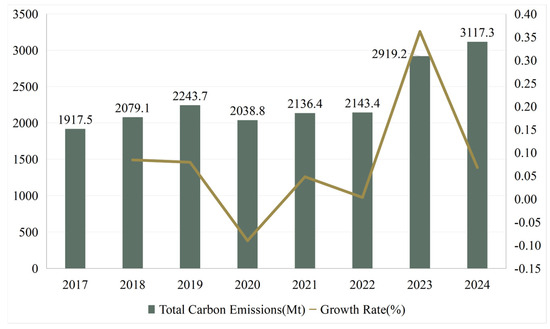
Figure 2.
Trends in Chengdu’s transportation carbon emissions: 2017–2024.
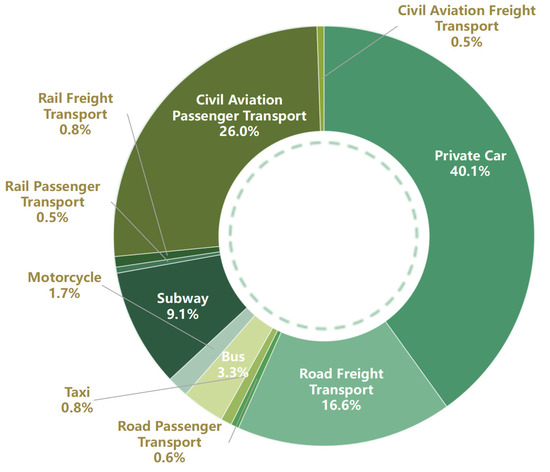
Figure 3.
Composition of Chengdu’s transportation carbon emissions in 2024.
3.2. Carbon Emissions from Private Car Travel
According to calculations, private vehicle travel accounts for the highest proportion of transportation carbon emissions in Chengdu. The estimated carbon emissions from private car travel between 2017 and 2024 are presented in Table 5, with the trend illustrated in Figure 4. The data on private car ownership is sourced from the Chengdu Municipal Transport Bureau. The average annual growth rate of carbon emissions is 5.8%, and it is projected that private vehicle travel will generate 12.496 million tons of carbon emissions in 2024.

Table 5.
Estimated carbon emissions from private car travel in Chengdu, 2017–2024.

Figure 4.
Trend chart of private vehicle ownership and carbon emissions from private vehicles in Chengdu, 2017–2024.
3.3. Carbon Emissions from Public Transportation
This study defines public transportation emissions as those arising from metro and public bus usage. The statistics on bus fleet size and subway passenger turnover are sourced from the Chengdu Municipal Transport Bureau. Table 6 summarizes the annual emissions for this category. The analysis reveals a substantial increase in metro-related emissions, rising from 0.951 MtCO2 in 2022 to 2.839 MtCO2 in 2024. This surge is attributed to Chengdu’s post-pandemic status as a major tourist destination, coupled with the continuous expansion of its metro network, which enhanced accessibility and affordability. In 2024, total emissions from public transportation amounted to 3.861 MtCO2, significantly lower than those from private car travel. The trend in carbon emissions is illustrated in Figure 5.

Table 6.
Estimated carbon emissions from public transportation in Chengdu, 2017–2024.

Figure 5.
Trend chart of carbon emissions from public transportation in Chengdu, 2017–2024.
3.4. Carbon Emissions from Freight Transport
As Chengdu lacks waterway freight infrastructure, this study focuses on emissions from road, rail, and air freight. The freight turnover data for road, railway, and air cargo transportation are sourced from the Chengdu Municipal Transport Bureau. Table 7 provides a detailed breakdown. Road freight consistently dominated this category, contributing over 92% of total freight emissions in recent years. In 2024, freight transport emissions totaled 5.587 MtCO2, comprising 5.168 MtCO2 from road transport, 0.254 MtCO2 from rail freight, and 0.165 MtCO2 from air freight. The trend of carbon emissions is illustrated in Figure 6.

Table 7.
Estimated carbon emissions from freight transport in Chengdu, 2017–2024.
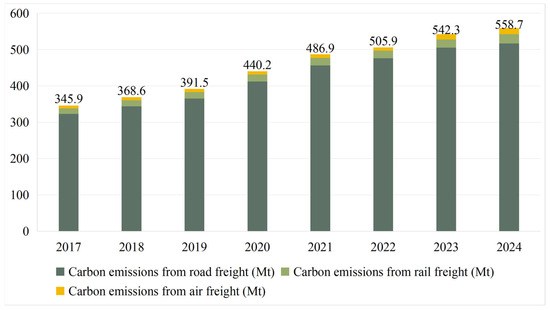
Figure 6.
Trend chart of carbon emissions from freight transport in Chengdu, 2017–2024.
4. Discussion
4.1. Analysis of Vehicle Energy Structure
The calculated results reveal that Chengdu’s transportation sector exhibits elevated carbon emissions, attributed to the following two primary factors: (1) a large and growing motor vehicle population and (2) a suboptimal energy structure dominated by fossil fuels. By the end of 2024, Chengdu’s motor vehicle population reached 7.66 million units (including approximately 6.30 million passenger cars), ranking first nationally. Projections indicate this figure will exceed 8.5 million units by 2030, as illustrated in Figure 7. The trends in Chengdu’s new energy vehicle (NEV) population and the fuel-type composition of Chengdu’s passenger car population are illustrated in Figure 8 and Figure 9, respectively, with all data sourced from the Chengdu Municipal Transport Bureau.

Figure 7.
Trends in Chengdu’s motor vehicle population.
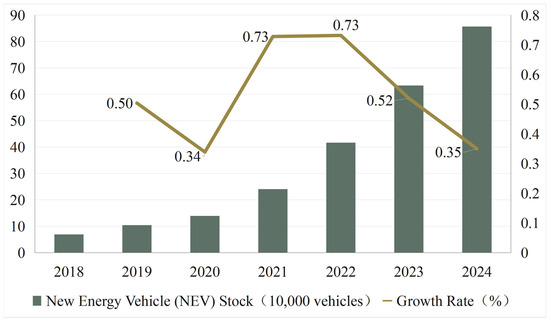
Figure 8.
Trends in Chengdu’s new energy vehicle (NEV) population.

Figure 9.
Fuel-type composition of Chengdu’s passenger car population.
Notably, the energy mix of Chengdu’s vehicle fleet remains heavily reliant on conventional fuels. Gasoline-powered vehicles dominate, accounting for 91.2% of the total fleet, while new energy vehicles (NEVs) represent only 4.8%. In 2024, NEVs numbered approximately 850,000 units, constituting less than 12% of the total fleet—a significant gap compared to leading cities in NEV adoption. Within this category, passenger cars predominantly rely on gasoline, with NEVs constituting a mere 10%. Despite policy efforts in public transport electrification, over 90% of newly registered passenger vehicles continue to utilize fossil fuels, reflecting limited regulatory constraints on private vehicle energy transitions.
4.2. Analysis of Travel Mode Structure
In Chengdu’s central urban area, private car usage dominates resident travel patterns, accounting for 45.4% of total trips, followed by public bus transit (16.0%), metro systems (30.9%), and taxi/ride-hailing services (7.2%), as illustrated in Figure 10. This skewed modal split stems from the following two systemic drivers: (1) persistent reliance on private cars due to low ownership/operational costs and insufficient high-quality alternatives, rendering metro network expansions ineffective in curbing car dependency, and (2) underdeveloped low-carbon mobility culture, characterized by preferences for high-displacement vehicles, prolonged engine idling, and inadequate vehicle maintenance, compounded by weak policy advocacy. Survey data reveal that 20% of private car trips cover short distances (≤5 km), with modeling indicating that substituting these trips with green mobility options (e.g., cycling and walking) could yield annual CO2 reductions of at least 500,000 metric tons.
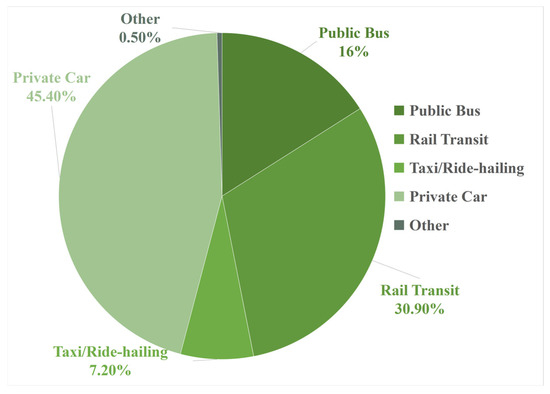
Figure 10.
Composition of travel modes in Chengdu’s central urban area.
4.3. Analysis of Freight Transport Structure
Chengdu’s freight transport structure faces the following dual challenges: (1) excessive reliance on road transport, which accounts for over 84.6% of total freight volume (significantly higher than the <15% share of rail transport, as shown in Figure 11), resulting in disproportionately high carbon emissions and hindering sustainable urban development and transport optimization, and (2) low adoption rates of new energy vehicles (NEVs) in truck fleets, with over 40% of trucks meeting only China IV or lower emission standards (compared to <15% in Beijing), alongside a high prevalence of high-pollution vehicles, including 14% China III or older trucks (exceeding Beijing’s 5%) and 45% diesel-powered trucks (surpassing Beijing’s 27%). NEVs constitute merely 14% of Chengdu’s truck fleet (vs. >20% in Shenzhen), with critically low electrification rates in public service vehicles (e.g., dump trucks and concrete mixers) and medium-/heavy-duty trucks (<1%), exacerbating the sector’s environmental impact.
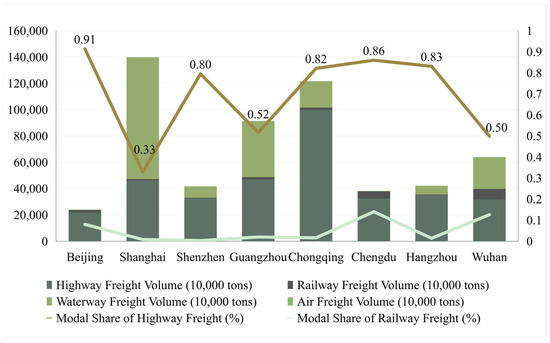
Figure 11.
Comparison of freight structure across cities.
5. Green and Low-Carbon Development Pathways
Drawing on advanced urban practices and Chengdu’s contextual realities, this strategy focuses on key areas of pollution and carbon reduction in transportation, balancing critical factors such as primary pollution sources, cost–benefit investments, and socio-economic impacts. Through a dual approach of enhancement and reduction, it aims to achieve tangible progress in emission and carbon mitigation within Chengdu’s transport sector.
5.1. Holistic Integration of “Rail + Bus + Non-Motorized Transport” Networks
5.1.1. Establish a “Four Synchronizations” Coordination Mechanism
Implement a synchronized planning, land acquisition, construction, and completion process for rail transit station-supporting facilities, including bus stops, taxi stands, and non-motorized vehicle parking. Develop binding standards for intermodal infrastructure allocation (e.g., bus terminals and bike-sharing hubs). Integrate station and transfer facility designs during feasibility and preliminary design phases. Ensure concurrent construction of rail stations and transfer hubs, as well as incorporate multimodal connectivity assessments as a prerequisite for rail project acceptance and operational commissioning.
5.1.2. Optimize Rail–Bus Network Synergy
Adopt a regionally differentiated strategy. Reduce bus–rail route redundancy in core urban zones (“5 + 1” districts) and radial corridors while strengthening rail–bus connectivity in peripheral areas (“7 + 2” districts). Refine the multi-tiered bus network by prioritizing express lines for medium–long distances (complementing rail coverage) and feeder lines for short-haul trips (seamlessly connecting to rail nodes), fostering functional complementarity and coordinated development.
5.1.3. Enhance Integrated Operational Efficiency and Service Quality
Achieve full-coverage, interconnected service guidance across all networks. Standardize signage parameters (layout, placement, and content) for seamless rail–bus transfers, creating age-inclusive, user-friendly environments. Strengthen wayfinding systems for high-traffic public service hubs and tourist attractions within walkable catchment areas, ensuring intuitive navigation for pedestrian flows.
5.2. Optimize Freight Structure to Advance Green Logistics
5.2.1. Enhance Freight Corridor Infrastructure
Accelerate the development of expressway networks to strengthen road freight corridors. Prioritize key projects including the Fifth Ring Road construction, elevated upgrades of Chengdu–Luojiang Avenue and Chengdu–Longquan Avenue, freight corridor enhancements on Huoyun Avenue, and rapid transit node improvements on Dajian Road while initiating feasibility studies for relocating Dajian Road. These efforts will establish an external freight network anchored by a “3 circumferential and 17 radial” expressway system and a municipal freight system centered on a “3 loops, 15 radials, and 6 connectors” rapid road network. This framework supports the “intra-ring passenger priority, extra-ring freight focus” traffic strategy, minimizing freight interference with urban commuting flows.
5.2.2. Systematically Refine Citywide Freight Management
Adopt an integrated citywide approach to regulate non-essential truck traffic. Enforce strict controls on transiting and non-local trucks under the principle of “divert through traffic, restrict non-local vehicles, ban high-emission trucks”, while advancing policies to phase out Yellow-label and China III standard vehicles. Implement categorized management for essential urban freight, as follows:
Industrial logistics: Ensure raw material input and finished product output through spatiotemporal passenger–freight separation or new energy vehicle (NEV) replacements to maintain production continuity.
Civilian supply chains (wholesale markets and supermarkets): Transition to NEVs and nighttime deliveries to meet daily supply demands.
Logistics hubs (postal, express, and warehousing): Optimize freight corridors via upgraded road standards and route adjustments to enhance efficiency.
5.2.3. Promote Rail-Oriented Modal Shift for Suitable Cargo
Expand rail-compatible industries, such as automotive, aerospace, rail equipment, advanced materials, and green food processing, clustering manufacturing parks and industrial zones near rail terminals to boost rail-suitable export volumes. Incentivize diversified rail services, including bulk cargo direct trains, container block trains, and point-to-point freight lines, to shift commodities like retail goods, fuels, and commercial vehicles from road to rail. Support dedicated rail spur construction for large enterprises and logistics parks, and establish “virtual rail stations” in industrial zones and highway logistics hubs, transforming rail transport from traditional “station-to-station” to “door-to-door” services.
5.3. Accelerate New Energy Vehicle Adoption to Reduce Source Emissions
5.3.1. Expedite Phasing out of Aging Vehicles
Capitalizing on the 2023 Implementation Plan for Incentivizing Early Retirement of Aging Commercial Vehicles, launch a targeted campaign to accelerate retirement of outdated trucks. Establish a comprehensive registry of aging vehicles and owners, coupled with proactive outreach, on-site notifications, and intensified road inspections. Expand Yellow-label vehicle-restricted zones and tighten management policies to phase out high-emission, energy-intensive vehicles. Explore a fuel vehicle exit roadmap to gradually restrict and eventually terminate fossil-fuel vehicle sales and usage.
5.3.2. Pioneer Key Sector Electrification
As a national pilot demonstration zone for full electrification of public sector vehicles, prioritize pure electric adoption in urban buses and taxis to achieve complete public transit electrification. Systematically transition ride-hailing, sanitation, postal, and light logistics fleets to new energy or clean energy vehicles. Strengthen incentives for NEV purchases and usage through stable, long-term policy frameworks, fostering industry growth. Target 1 million NEVs in operation by 2025, positioning Chengdu as a national leader in green mobility.
5.3.3. Rapid Deployment of Charging Infrastructure
Enforce mandatory charging facility integration standards for all new/renovated buildings, as follows:
- Residential complexes: 20% equipped with chargers and 80% pre-wired;
- Office buildings: 25% charging-ready;
- Commercial/public buildings: 20% charging-ready.
Ensure DC fast-charging stations constitute ≥15% of total installations. Align with the 2025 target of 200,000 cumulative charging points through strict compliance with zoning regulations and dedicated infrastructure planning.
5.4. Strengthen Policy and Regulatory Frameworks
5.4.1. Optimize Traffic Demand Management Policies
Align with China’s dual-carbon goals and analyze spatiotemporal traffic patterns to objectively evaluate current vehicle restriction policies (time slots, zones, and targets). Refine the license-plate-based traffic rationing system (particularly for trucks) to align with Chengdu’s green mobility transition. Revamp on-street parking fee policies by adjusting differentiated pricing in the “5 + 1” districts and coordinating unified optimization across the “12 + 2” central urban areas and peripheral regions. Establish a citywide, multi-tiered parking fee system incorporating spatial differentiation, time-of-day pricing, vehicle-type distinctions, precision timing, and progressive rate increments. Advance feasibility studies for vehicle quota controls, congestion charging, and low-emission zones to curb non-NEV ownership growth and usage, thereby boosting green travel modal share and reducing transport-sector emissions.
5.4.2. Enforce Rigorous Governance to Foster Green Mobility Culture
Firstly, strictly regulate illegal parking within 150 m of rail stations. Implement yellow curb markings and bus lane demarcations, supported by frequent patrols and strict penalties to eliminate unauthorized parking, ensuring unimpeded traffic flow. Secondly, standardize shared bike parking at transit hubs through geo-fenced designated zones and enhanced digital management, preventing chaotic bike and maintaining orderly station access.
5.4.3. Strengthen Multi-Stakeholder Collaboration Mechanisms
Firstly, enhance institutional coordination by establishing cross-regional linkages (e.g., Chengdu–Chongqing Economic Circle and metropolitan clusters), interdepartmental partnerships, and public–private collaborations, leveraging the Chengdu Logistics Association to foster co-governance. Secondly, drive innovation by developing green logistics pilot zones (one per district/county) with tailored action plans and integrate truck operations into the “Carbon Incentive Mobility” platform to refine management and cultivate industry-leading freight enterprises. Finally, amplify public engagement through integrated campaigns, proactive monitoring, and responsive communication to solidify societal support for green mobility.
6. Conclusions
This study calculates the changes in total carbon emissions from Chengdu’s transportation sector in recent years. Through categorized quantification of emissions generated by different transport modes, it innovatively conducts statistical analyses of carbon footprints from the perspectives of travel modes and transportation structure. Based on the computational results, the following conclusions are drawn:
- (1)
- By the end of 2024, Chengdu’s motor vehicle population reached 7.66 million units (ranking first nationally), with total transportation emissions amounting to 31.17 million metric tons (MtCO2)—a 0.7% increase from 2023. This growth poses significant challenges to sustainable urban development and transportation structure optimization.
- (2)
- Private car travel contributes 40.1% of the sector’s total emissions, driven by two structural inefficiencies: (i) a suboptimal vehicle energy mix, with only 10% of passenger cars being new energy vehicles (NEVs), and (ii) an imbalanced travel mode structure, where private cars account for 45.4% of trips in central urban areas, compounded by low public transit ridership and insufficient public awareness of green mobility.
- (3)
- In 2024, freight transport generated 5.587 MtCO2, with road freight contributing 5.168 MtCO2 (92% of the total). Structural deficiencies include overdependence on high-pollution trucks, with >40% complying with China IV or lower emission standards, underscoring the urgent need to shift freight from road to rail.
Building on the systemic analysis, this study proposes green and low-carbon development pathways for Chengdu’s transportation sector. As cities serve as pivotal arenas for achieving carbon peaking and neutrality, transportation represents a strategic lever for urban decarbonization. Confronting rapid demand growth, spatial resource constraints, and pronounced environmental externalities, Chengdu urgently requires an integrated strategy featuring unified citywide coordination, root-cause mitigation, and precision governance to optimize its transportation structure. Core pathways include vehicle electrification (prioritizing NEV adoption), emission standard escalation (phasing out high-pollution fleets), green modal shift (enhancing rail and public transit), and carbon sink institutionalization (establishing offset mechanisms). Critical priorities involve increasing NEV penetration rates, optimizing private car and freight transport structures, and implementing robust safeguards across policy, legislation, funding, technology, and institutional frameworks. These multi-pronged measures, grounded in a “whole-system” approach, will position Chengdu as a trailblazer in urban transportation decarbonization, balancing developmental needs with climate imperatives.
Author Contributions
Conceptualization, Q.L. and C.M.; methodology, Q.L.; software, Q.L.; validation, Q.L.; formal analysis, Q.L.; investigation, Q.L.; writing—original draft preparation, Q.L.; writing—review and editing, Q.L. and C.M.; supervision, Q.L.; project administration, Q.L. and C.M.; funding acquisition, C.M. All authors have read and agreed to the published version of the manuscript.
Funding
This research was funded by the JOINT PROJECT OF THE NATURAL SCIENCE FOUNDATION OF HEILONGJIANG PROVINCE, grant number: LH2023G002.
Data Availability Statement
The original contributions presented in this study are included in the article. Further inquiries can be directed to the corresponding author.
Acknowledgments
The authors would like to acknowledge the Natural Science Foundation of Heilongjiang Province for providing support for this study. In addition, the authors thank the anonymous reviewers who provided useful insights and suggestions.
Conflicts of Interest
Author Qinyi Liu was employed by the company Beiing Huayun Traffic Consulting Development Company. The remaining authors declare that the research was conducted in the absence of any commercial or financial relationships that could be construed as a potential conflict of interest. The authors declare that this study received funding from the JOINT PROJECT OF THE NATURAL SCIENCE FOUNDATION OF HEILONGJIANG PROVINCE. The funder was not involved in the study design, collection, analysis, and interpretation of data; the writing of this article; or the decision to submit it for publication.
References
- Research and Markets Adds Report: Global Dual Carbon Battery Market Outlook to 2020. Wireless News, 2016.
- Gao, Y.; Chong, H.C.; Liu, G. Identification of carbon responsibility factors based on energy consumption from 2005 to 2020 in China. Energy 2024, 296, 131247. [Google Scholar] [CrossRef]
- Jian, H.; Lin, C.; Na, Z. A Statistical Review of Considerations on the Implementation Path of China’s “Double Carbon” Goal. Sustainability 2022, 14, 11274. [Google Scholar] [CrossRef]
- Wu, Y. Dilemmas and Strategies for Global Climate Governance in Industry 4.0. Acad. J. Environ. Earth Sci. 2022, 4, 6. [Google Scholar]
- Yuan, Z.Z.; Yuan, X.J.; Yang, Y. Greenhouse gas emission analysis and measurement for urban rail transit: A review of research progress and prospects. Digit. Transp. Saf. 2023, 2, 36–51. [Google Scholar] [CrossRef]
- Research Group of the Major Innovation Project of the Chinese Academy of Social Sciences. Core Theoretical Foundations of the Autonomous Knowledge System for Ecological Civilization and Policy Research (2024YZD001). J. Eco-Civiliz. Stud. 2024, 1–4. Available online: http://kns.cnki.net/kcms/detail/10.1979.C.20250103.1618.006.html (accessed on 24 May 2025).
- Li, L.; Wang, X.Y. Research on Optimization of Urban Transportation Structure in Beijing under Dual-Carbon Goals. Transp. Energy Conserv. Environ. Prot. 2022, 18, 52–56. [Google Scholar]
- Wu, X.J.; Zhou, Y.L.; Bi, Q.H. Forecasting Carbon Emissions in Changsha’s Transportation Sector. Transp. Constr. Manag. 2023, 5, 150–152. [Google Scholar]
- Pascal, P. The effect of transportation policies on energy consumption and greenhouse gas emission from urban passenger transportation. Transp. Res. Part A Policy Pract. 2008, 6, 901–909. [Google Scholar]
- Cevero, R.; Kockelman, K. Travel demand and the 3Ds: Density, diversity, and design. Transp. Res. Part D Transp. Environ. 1997, 2, 199–219. [Google Scholar] [CrossRef]
- Su, T.Y.; Zhang, J.H.; Li, J.L. Empirical Study on Influencing Factors of Urban Transportation Carbon Emissions: Evidence from Panel Data of Beijing, Tianjin, Shanghai, and Chongqing. Ind. Eng. Manag. 2011, 16, 134–138. [Google Scholar] [CrossRef]
- Miao, M.Y.; Wang, L.L.; Li, F.F. Optimizing the “Four Major Structures” to Explore a Unique Low-Carbon Development Path for Megacities. Chengdu Dly. 2021, 12, 29. [Google Scholar] [CrossRef]
- Decision of the Chengdu Municipal Committee of the Communist Party of China on Optimizing Spatial, Industrial, Transportation, and Energy Structures to Promote Green and Low-Carbon Urban Development with Carbon Peaking and Neutrality Goals. Xianfeng 2022, 1, 23–30.
- Notice of the Chengdu Municipal People’s Government General Office on Issuing the Action Plan and Policy Measures for Optimizing Transportation Structure to Promote Green and Low-Carbon Urban Development. Chengdu Munic. Gov. Gaz. 2022, 8, 12–17.
- Mao, J. Optimizing the “Four Major Structures” to Drive Comprehensive Green and Low-Carbon Transformation in Chengdu. Xianfeng 2024, 7, 50. [Google Scholar]
- Yang, J.; Tang, L.; Mi, Z. Carbon emissions performance in logistics at the city level. J. Clean. Prod. 2019, 231, 1258–1266. [Google Scholar] [CrossRef]
- Liu, Y.; Yu, Y.; Baldacci, R. Optimizing carbon emissions in green logistics for time-dependent routing. Transp. Res. Part B 2025, 192, 103155. [Google Scholar] [CrossRef]
- Ding, J.X.; Jin, F.J.; Li, Y.J. Analysis of transportation carbon emissions and its potential for reduction in China. Chin. J. Popul. Resour. Environ. 2013, 11, 17–25. [Google Scholar] [CrossRef][Green Version]
- Liu, X.R.; Tang, J.Q.; Li, W.D. A Bibliometric Analysis and Visualization of Aviation Carbon Emissions Studies. Sustainability 2023, 15, 4644. [Google Scholar] [CrossRef]
- Jan, S.; Yang, L.; Stefan, S. Carbon emissions from European land transportation: A comprehensive analysis. Transp. Res. Part D 2023, 121, 103851. [Google Scholar]
- Intergovernmental Panel on Climate Change. 2006 IPCC Guidelines for National Greenhouse Gas Inventories; Institute for Global Environmental Strategies (IGES): Kanagawa, Japan, 2006.
- European Commission. The White Paper: Road Map to a Single European Transport Area. Towards a Competitive and Resource Efficient Transport System; European Commission: Brussels, Belgium, 2011; p. 9. [Google Scholar]
- Cheng, G.Z.; Liu, X.L.; Pei, Y.L. A review of research on public transport priority based on CiteSpace. J. Traffic Transp. Eng. 2023, 10, 1118–1147. [Google Scholar] [CrossRef]
- Leisch, J.P. New Concepts in Rail-Bus Interchange. Transp. Eng. J. ASCE 1974, 100. [Google Scholar] [CrossRef]
- Moussa Rushdy, R. Reducing carbon emissions in Egyptian roads through improving the streets quality. Environ. Dev. Sustain. 2022, 25, 1–22. [Google Scholar]
- Guo, C.; Xu, J. Carbon Emission Calculation Methods for Highway Tunnel Construction; Springer: Berlin/Heidelberg, Germany, 2022. [Google Scholar] [CrossRef]
- Dobers, K.; Ehrler, C.V.; Davydenko, Y. Challenges to Standardizing Emissions Calculation of Logistics Hubs as Basis for Decarbonizing Transport Chains on a Global Scale. Transp. Res. Rec. 2019, 2673, 502–513. [Google Scholar] [CrossRef]
- Cui, Q.; Lei, Y.L.; Li, Y. Protocol to calculate aircraft emissions for international air routes in South America. STAR Protoc. 2022, 4, 101952. [Google Scholar] [CrossRef]
- Deng, S.Y.; Mi, Z.F. A review on carbon emissions of global shipping. Mar. Dev. 2023, 1, 4. [Google Scholar] [CrossRef]
- Stefano, M.; Lu, Z.M. Carbon emission and cost analysis of vehicle technologies for urban taxis. Transp. Res. Part D 2021, 99, 102994. [Google Scholar]
- Ang, B.W. The LMDI approach to decomposition analysis: A practical guide. Energy Policy 2005, 33, 867–871. [Google Scholar] [CrossRef]
- Wang, M.; Zhu, C.Z.; Cheng, Y. The influencing factors of carbon emissions in the railway transportation industry based on extended LMDI decomposition method: Evidence from the BRIC countries. Environ. Sci. Pollut. Res. Int. 2022, 30, 15490–15504. [Google Scholar] [CrossRef]
- Pu, J.; Cai, C.; Guo, R. Carbon emissions of urban rail transit in Chinese cities: A comprehensive analysis. Sci. Total Environ. 2024, 921, 171092. [Google Scholar] [CrossRef]
- Jie, P.; Zhong, L.S.; Feng, W. Study on Evaluation System of Aircraft Carbon Emissions for China Civil Aviation. Adv. Mater. Res. 2011, 356–360, 825–829. [Google Scholar]
- Zhang, M.J.; Yang, S.W.; Wu, M.J.X.; Chen, F.Z. Research on the drivers of carbon emissions from highway trucks based on pathway analysis. In Proceeding of the International Conference on Smart Transportation and City Engineering (STCE 2023), Chongqing, China, 16–18 December 2023. [Google Scholar]
- ISO 14064-1:2018; Greenhouse Gases—Part 1: Specification with Guidance at the Organization Level for Quantification and Reporting of Greenhouse Gas Emissions and Removals. International Organization for Standardization (ISO): Geneva, Switzerland, 2018.
- Jiang, X.; Su, M.; Li, R. Investigating the Factors Influencing the Decoupling of Transport-Related Carbon Emissions from Turnover Volume in China. Sustainability 2018, 10, 3034. [Google Scholar] [CrossRef]
- Hou, L.C.; Wang, Y.P.; Zheng, Y.H. The Impact of Vehicle Ownership on Carbon Emissions in the Transportation Sector. Sustainability 2022, 14, 12657. [Google Scholar] [CrossRef]
- WRI & WBCSD. GHG Protocol Calculation Tools for Mobile Combustion; Greenhouse Gas Protocol: Washington, DC, USA, 2005; Available online: https://ghgprotocol.org/calculation-tools (accessed on 24 May 2025).
- National Emission Standards for Hazardous Air Pollutants: Chemical Manufacturing Area Sources Technology Review. Dly. J. United States Gov. 2025, 90, 7942.
- Energy-saving and New Energy Vehicle Industry Development Plan (2012–2020). Earth 2015, 9, 13.
Disclaimer/Publisher’s Note: The statements, opinions and data contained in all publications are solely those of the individual author(s) and contributor(s) and not of MDPI and/or the editor(s). MDPI and/or the editor(s) disclaim responsibility for any injury to people or property resulting from any ideas, methods, instructions or products referred to in the content. |
© 2025 by the authors. Licensee MDPI, Basel, Switzerland. This article is an open access article distributed under the terms and conditions of the Creative Commons Attribution (CC BY) license (https://creativecommons.org/licenses/by/4.0/).